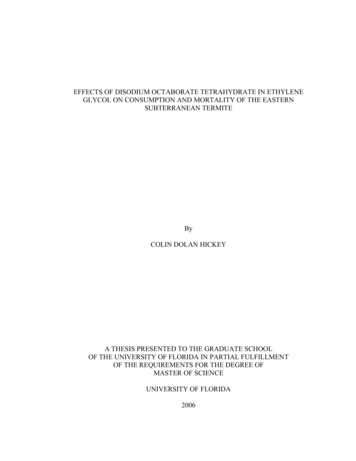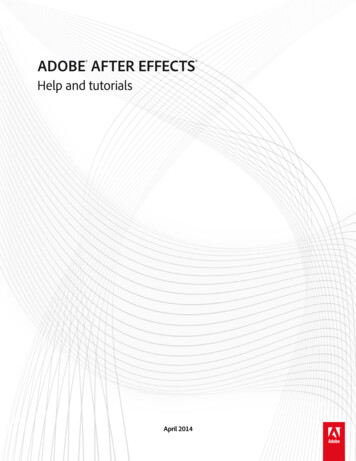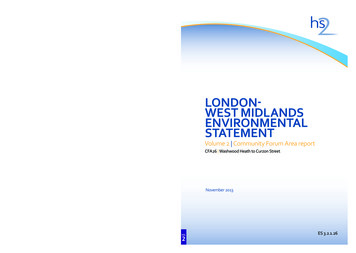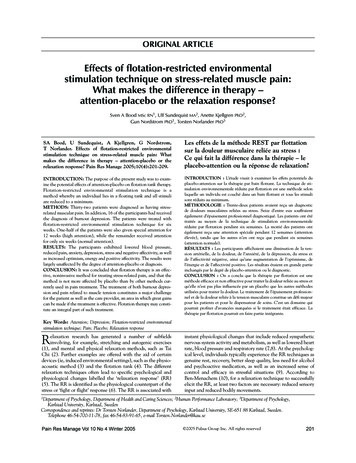
Transcription
EFFECTS OF DISODIUM OCTABORATE TETRAHYDRATE IN ETHYLENEGLYCOL ON CONSUMPTION AND MORTALITY OF THE EASTERNSUBTERRANEAN TERMITEByCOLIN DOLAN HICKEYA THESIS PRESENTED TO THE GRADUATE SCHOOLOF THE UNIVERSITY OF FLORIDA IN PARTIAL FULFILLMENTOF THE REQUIREMENTS FOR THE DEGREE OFMASTER OF SCIENCEUNIVERSITY OF FLORIDA2006
Copyright 2006byColin Dolan Hickey
This thesis is dedicated to my parents, Charles and Janice Hickey.
ACKNOWLEDGMENTSI would like to thank my friends of the Urban lab, especially Dave “Face” Melius,Justin “Dursban” Sanders and Ryan “Tarzan” Welch, for the good times and for thesupport and motivation of Pili Paz, who put me back on track to finish writing my thesis.I thank my family for their patience and advice through the ups and downs of grad schooland life in Florida.Special recognition goes to Gil S. Marshall and Tiny Willis. If not for their helpwith supplies, advice and friendship, I would still be searching for the pipette and tryingto figure out how to get research supplies. I greatly appreciate the assistance of DebbieHall, her assistant Josh Crews, and Nancy Sanders for helping me negotiate the labyrinthof administrative details necessary for completing my degree.I thank Dr. Faith Oi, whose workspace I used in my usual messy way (of course inthe name of good science) and whose helpful scientific guidance and practical advice andrecommendations were sincerely appreciated. I thank Cindy Tucker for her generousassistance with termite colonies for my research and reading and discussing termiteresearch with me, especially mine.My deepest thanks go to Dr. Philip Koehler for giving me this unique opportunityand putting up with my unorthodox methods. His help and guidance were essential forme to complete my degree. I also thank the rest of my graduate committee, Drs. SimonYu and Brian Cabrera.iv
TABLE OF CONTENTSpageACKNOWLEDGMENTS . ivLIST OF TABLES. viiLIST OF FIGURES . viiiABSTRACT. ixCHAPTER1LITERATURE REVIEW .1Termite Biology.1Control Methods .6Wood Treatment and Preservation .8Disodium Octaborate Tetrahydrate in Ethylene Glycol .11Statement of Purpose .132MATERIALS AND METHODS .15Insects .15Lethal Time Bioassay .15Chemicals .15Application of Treatments.15Bioassay Procedure .16Data Analysis.17Consumption and Mortality Bioassay .17Chemicals .17Application of Treatment .17Bioassay Procedure .18Data Analysis.193RESULTS .20Lethal Time of DOT/glycol. .20Lethal Time of Aqueous DOT and Ethylene Glycol .20DOT/glycol Consumption .22DOT/glycol Mortality.23v
Aqueous DOT/Propylene Glycol Consumption .24Aqueous DOT/Propylene Glycol Mortality.254DISCUSSION.36LIST OF REFERENCES.42BIOGRAPHICAL SKETCH .47vi
LIST OF TABLESpageTable3-1. Lethal effects of DOT/glycol-treated filter papers on R flavipes workers (n 100).263-2. Toxicity of disodium octaborate tetrahydrate in ethylene glycol to 100 R. flavipesworkers. .283-3. Lethal effects of borate and ethylene glycol treated filter papers on R flavipesworkers (n 100) .293-4. Toxicity of disodium octaborate tetrahydrate and ethylene glycol to 100 R.flavipes workers.313-5. Consumption (mg) of DOT/glycol treated filter paper by R. flavipes workers (n 200) and resultant mortality .323-6. Consumption (mg) of aqueous DOT and DOT/propylene glycol treated filterpaper by R. flavipes workers (n 200) and resultant mortality .33vii
LIST OF FIGURESpageFigure3-1. Consumption of filter paper (mg) by termites as a function of DOT ingested (µg).Consumption was observed at 192 h.The graph was charted using theconsumption data from the DOT/glycol consumption/mortality bioassay. .343-2. Log µg ingestion of DOT per termite as a function of mortality (%). Mortalitywas recorded at 192 h after treatment and corrected by Abbott’s formula (SAS2001).35viii
Abstract of Thesis Presented to the Graduate Schoolof the University of Florida in Partial Fulfillment of theRequirements for the Degree of Master of ScienceEFFECTS OF DISODIUM OCTABORATE TETRAHYDRATE IN ETHYLENEGLYCOL ON CONSUMPTION AND MORTALITY OF THE EASTERNSUBTERRANEAN TERMITEByColin Dolan HickeyMay 2006Chair: Philip KoehlerMajor Department: Entomology and NematologyThe economic impact of termites on a yearly basis is staggering. From pre- andpost-construction treatments, re-treatments, and repair costs, termite control climbs intobillions annually. Termites and humans have developed a conflict of interest betweenfinished wood products for construction and aesthetics. Recent interest in boron as apotential wood preservative has been spurned by the search for environmentally friendlyand cost-effective replacements to existing wood preservation strategies. Disodiumoctaborate tetrahydrate (DOT), a borate salt, is a broad spectrum toxicant that acts againstfungi and insects with a low mammalian toxicity and has been proven particularlyeffective against termites. Borates diffuse through wood because they dissolve in water.The loading capacity of DOT is increased when ethylene glycol is used as a solvent. Rateof mortality and deterrence of feeding in Reticulitermes flavipes were evaluated withtreatment of filter paper using DOT in ethylene glycol.ix
A lethal time bioassay was conducted to determine how quickly contact withDOT/glycol killed termites. DOT killed termites rapidly. At DOT/glycol concentrations 7,774 ppm, termite mortality was 85% within 192 h. Although ethylene glycol, acontact desiccant, accelerated mortality because it contacted the termites in theDOT/glycol treatment, aqueous treatments of 7,774 ppm DOT caused 85% mortalitywithin 192 h. DOT/glycol treatments exhibited relatively high LT50s. The LT50 of303,209 ppm DOT/glycol was 49.69 h.R. flavipes consumption of filter paper treated with different concentrations of DOTwas conducted to determine deterrence of feeding. Termites began feeding on the filterpapers placed in each container in 24 h. Termite consumption of treated filter papersdecreased as concentrations of DOT increased. At 783 ppm, DOT reduced celluloseingestion by 10%. At 303,209 ppm DOT, ingestion was reduced by 84%. Despitereduction in consumption of filter paper, DOT consumption increased with higherconcentration of treatment. Filter paper treated with DOT did not deter feeding.When mortality of termites was observed at 192 h, greater mortality had occurredin treatments at the highest concentration of DOT (81.3% for 303,209 ppm DOT).Termites were ingesting greater quantities of DOT with higher concentration oftreatment. High mortality was caused by ingestion of lethal doses of DOT. My studydetermined that DOT kills termites rapidly by ingestion, consequently limiting damage towood in the structure. DOT/glycol treatments were not found to be deterrents of feedingexcept at the highest concentrations. As a result, untreated wood in the structure can beprotected because treated wood would be a more convenient food source and thetreatment would probably not cause feeding deterrence.x
CHAPTER 1LITERATURE REVIEWTermite BiologyTermites (Isopterans) are medium sized, social insects that consume cellulose astheir main source of nourishment. Isoptera have similar sized fore and hind wings andantennae are monoliform. Specific morphological characteristics that differentiatetermites into different families are divided between the soldier and alate forms of eachspecies (Snyder 1948). Wing characters, presence of a fontanelle and ocelli, pronotumshape and forewing scale size in relation to pronotum are physical keys to determinetaxonomy in alates (Scheffrahn and Su 1994). For the soldier caste, head size andmandibles are the keys to determine taxonomy of termites.Subterranean termites are distributed virtually across the entire United States. Theendemic Reticulitermes spp. are most prolific, but genera Coptotermes, Heterotermes andProrhinotermes are also present (Light 1934). In urban areas, human structures providetermites with a host of advantageous conditions. Because Americans have favoredconstruction with wood, termites have become a constant threat to structures (Forschler1999). Structures also provide harborage and moisture, allowing termites’ access to themost important conditions for their survival.Isoptera is believed to have evolved during the Permian period (200 mya) from aline that branched from Blattaria (Krishna 1969). Similarities between the primitivetermite species in Australia, Mastotermes darwiniensis Froggart, and primitive Blattariaare evidence of this common ancestry (Thorne 1997). However, Isopterans have evolved1
2a dynamic social structure unlike other insects. Unlike Hymenoptera, the social structureof Isoptera does not function on the basis of a haplo-diploid reproduction (Wilson 1971).All termites are diploid. There are many factors that have influenced the evolution oftermites and predisposed them to eusocial organization. Dense familial habitats with acommon food source, the slow development and overlap of generations, a high mortalityrisk for individuals outside of the familial habitat and associated advantages of a mutualand community defense, and the obligate dependence on recycled flagellated protozoansfor the digestion of material containing cellulose, are plausible conducive elements thatcontributed to the social behavior that has evolved in Isoptera (Bartz 1979; Thorne 1997).Subterranean termites are aptly named by their cryptobiotic behavior associatedwith soil. Rhinotermitidae tunnel through soil with an objective of locating food sources.Instances in which wood and soil are in contact are conducive to subterranean termiteinfestation (Potter 2004). Where non-organic materials impede termites from reachingwood, termites frequently build shelter tubes over the material to reach on the wood.Once a food source is located, the tunnel is reinforced with anal cement (Stuart 1967).Various factors, including the species of termite and the size and the quality of the foodsource, influence the intensity of termite feeding after a food source has been discovered.Communication in termites is a successful adaptation that has enabled termites tomaintain and defend efficient, well-organized colonies. Because termite soldiers andworkers are blind, pheromones are the most important method of communication intermites (Clement and Bagneres 1998). Termites use pheromones to mark trails for moreefficient foraging. Although (Z,Z,E) 3,6,8 dodecatrien-1-ol has been found as a principalpheromone marker in termites, extracts from C. formosanus trails provide evidence for
3other trail following compounds (Matsumura et al. 1968; Tokoro et al. 1994).Pheromones are used to differentiate caste members during development. Speciesspecific behaviors are determined by pheromones and likewise pheromones elicit otherspecific responses, including recruitment to food sources and for defense, as well asfunctioning as a sex pheromone for alates. However, experiments by Cornelius and Bland(2001) failed to detect any species-specific pheromone trail following behavior. Colonyspecific cuticular hydrocarbons prevent intruders from other colonies of the same speciesfrom infiltrating the nest, although agonism studies have determined that colony behaviorto inter-colony influences remain open and closed at different times depending on seasonand weather.Termite workers groom other members of the colony to remove potentiallyparasitic fungi and bacteria with their mouthparts (Thorne 1996). Termites participate instomadeal and proctadeal trophallaxis, the sharing of regurgitated and partially digestedfood for nutrient and symbiotic exchange (McMahan 1969). Soldiers cannot feed in themanner of worker termites because of their elongate mandibles and therefore soldiersreceive nutrients from their nestmate workers via trophallaxis. Furthermore, because theobligate symbionts in the midgut are shed with the midgut lining after each larval instar,the flagellated protozoans that are lost need to be replaced for termites to feed. Thus,trophallaxis among nest-mates maintains that developing termites receive the symbiontsthat enable them to be productive colony members (McMahan, 1969).The termite life cycle is hemimetabolous and the development follows threedistinct pathways: reproductive, soldier and worker. The queen or secondary reproductivelays eggs in the nest. These eggs hatch into larvae that in turn can develop into the three
4castes. Immature larvae follow two pathways of development. Soldiers and workersbranch from the developing imaginal reproductive track due to conditions present beforetheir first molt, not from a fate determined at birth or from the egg (Krishna 1969).Termite larvae following the reproductive pathway become nymphs. The nymphal stageis a precursor to the alate reproductive or the brachypterous reproductive. Alate orbrachypterous reproductives mate and the female renews the cycle by laying eggs.Termites show an amazing amount of developmental plasticity; nymphs can regress frombecoming reproductives to workers and under different conditions, such as the loss of thenested queen or male, workers can re-develop into functional reproductives (Lee andWood 1971).The reproductive caste can be further differentiated into primary and secondaryreproductives. Primary reproductives, alates or swarmers, have functional wings and areimportant in the dispersal and the foundation of new colonies. Mature colonies ofsubterranean termites produce massive numbers of alates of which their timely dispersalleads to numerous potential infestations. Secondary reproductives or neotenics develop asa result of changing conditions in the colony (Lee and Wood 1971). When a colonybecomes well established and sufficiently dispersed, or something happens to the queen(death or infertility), neotenics develop. In some instances, the secondary reproductives,due to their large numbers in the termite colonies rather than high fecundity, replace thequeen as the main source of eggs. There are two forms of secondary reproductives thatoccur in subterranean colonies. Brachypterous neotenics develop from nymphs and retainwing buds (not functional). Apterous neotenics derive from workers and have no wings
5or wing pads and have the smallest potential fecundity. In either case, secondaryreproductives mate without the possibility of a swarming flight (Thorne et al. 1999).A dark, enlarged, scleroticized head and the presence of large, obtuse mandiblesdistinguish the soldier caste. The sclerotized head capsule protects the soldiers fromfrontal attacks but their soft, white body is defenseless from the rear. Soldiers compriseonly 1-2% of the individuals of a R. flavipes termite colony (Howard and Haverty 1980).Their purpose in the colony has been traditionally been thought of as defensive, using thelarge mandibles to slice and cut invaders. They also have some function in colonyscouting and foraging, but depend on workers for nourishment because their specializedmouthparts prevent normal feeding (Weesner 1965). These members of the colony do notparticipate in reproduction.Workers are the driving force of each colony. They are the most numerous anddamaging form and the only caste that actually feeds on wood (Thorne et al. 1999). A“true worker” is a non-soldier, non-reproductive individual that differentiated early andusually irreversibly from the imaginal line. They are blind, have soft white bodies, andcontrol the tasks and chores of a successful colony (Thorne 1996). Workers tend the kingand queen, care for the brood, and feed soldiers through trophallaxis. In defense, workerssacrifice their bodies to block incoming predators from invading the nest (Snyder 1948).With chewing mouthparts, workers also use their feeding mandibles for a proactivedefense. In other termite species, fantastic mechanisms have been discovered for the roleof workers in defense of the colony (Thorne 1982, Thorne et al. 1999).With the ability to digest cellulose as a food source, termites have become a pest tohumans because of the widespread use of wood as a building material. Any cellulose
6material that comes into contact with the ground is an economic liability. Wood is at riskfor infestation even when elevated because of the termite ability to make shelter tubesand alate swarmers’ ability to infest aerially. Subterranean termite foraging is conductedprimarily with the construction of tunnels and underground galleries (Hedlund andHenderson 1999).Termites excavate tunnels for foraging in a generally even manner until either afood source is located, or a termite tunnel reaches a guideline (Potter 2004). A guidelineis a natural or artificial edge or pathway that allows termites to easily navigate throughthe soil with the least possible energy wasted on tunnel excavation. Root systems fromplants, pipes or a crack in concrete provide termites with access to simple unobstructedpathways. Forms of termite treatment methods, particularly baiting, can undermine thistermite behavior.Control MethodsThe economic impact of termites on a yearly basis is staggering. From pre- andpost-construction treatments, re-treatments, and repair costs, termite control climbs intobillions annually (Thorne et al. 1999). Termites and humans have developed a conflict ofinterest between finished wood products for construction and aesthetics. Controlmeasures probably began in ancient times with the Latin “termes,” and control stillremains a difficult task with this pest today.Termite barriers and shields are designed to block termites from undergroundaccess to cracks and voids that are mistakenly left in the construction, by using a fullstructure treatment of physical barriers that prevent termites from passing through to thestructure. There are several different technologies that have been developed (Potter2004). Some metal shields do not prevent infestation, but rather force termites to tube
7around the shield and become openly visible. Thus, the tubes can be mechanicallyremoved to prevent termites from reaching parts of the structure that have not beenshielded.Biological control of subterranean termites has been promising in the laboratory buthas suffered shortcomings in field trials. Termite predators are abundant in nature,termites are easy prey for many organisms including man, however only a few species ofants specialize in predation of termites. Nematodes and fungi have been studied in theireffectiveness against termites in the field. Nematode efficacy is precluded by a lack ofparasitization and the termites overwhelming avoidance (Epsky and Capinera 1988).Fungi treated in field studies caused significant mortality but became less effective overtime. Fungi offer the best classical control method, but the limitations of rearing Fungi ina cost-effective manner and their erratic performance in field studies, limits theplausibility of extensive fungi use (Delate et al. 1995).Liquid termiticide use can be divided into new construction preventativetreatments, post-construction preventative treatments and control treatments ofinfestations. New construction termiticides are applied to the soil underneath the area ofthe future slab foundation. Post-construction treatments are applied using a drill injectionof the termiticide under foundation or drenching a trench dug around the foundation.Termiticides can be divided between repellents and non-repellents. Historically,repellent termiticides have been used with a design of making a liquid barrier to preventstructural attack. In the wake of organophosphate (OP) phase out, several termiticideshave been marketed to replace the use of OPs for effective control of termites.Pyrethroids have practically replaced OPs for repellent barrier treatments because they
8function in a similar way to OP and repel termites away from the treatment zone (Potter2004).A novel understanding of termite foraging patterns and social behavior has aided inthe development of non-repellent termiticides. Non-repellent termiticides are invisibleand undetectable to foraging termites. Termites unknowingly come into contact with thechemical and then spread the lethal chemical via grooming and voluntary trophallaxis toother members of the colony. Non-repellent termiticides have proven remarkablyeffective and have become favored for prevention and control of subterranean termites.Termite baiting strategies have been developed in recent years, but there has been ahistorical precedent set by termite baiting (Potter 2004). Baiting stations are set in the soilflush with ground level and ‘baited’ with wood to monitor termite activity. As aprerequisite for effectiveness, sanitary methods must be undertaken to prevent termitesfrom alternate food sources and guidelines removed that will allow termites from evadingbait detection stations. Another key element in baiting effectiveness is placement.Placement of bait stations should coincide with infestation or likely entry points ofstructures. Once termite activity has been established, the station is set with activeingredient, and termites are returned into the bait station for self-recruitment. The logicbehind bait stations is that termites will consume active ingredient and then pass thechemical directly and indirectly to other nest-mates by trophallaxis. Baiting has become apopular alternative to liquid treatments because of the minimal pesticide residual and itsexternal application.Wood Treatment and PreservationWood has been favored as a construction material in the United States and aroundthe world. Hagen (1876) warned of the deleterious effects that wood-destroying
9organisms can inflict upon buildings and homes. Insomuch as wood is a food source for anumber of different organisms, particularly termites; preservation of wood has been asubject of concern for many years. Initially, developers of wood preservatives wereconcerned with wood that was in direct contact with the ground (McNamara 1990). In the19th century, log homes, railroad cross ties and wood beams to support mine shafts, werethe primary target of wood preservation strategies.There are a number of wood species that confer various physical and chemicalproperties that protect them from termite and other wood-destroying organisms. Thedensity of wood is a factor that predisposes wood to termite attack. Hardwoods areknown to be more termite resistant than softwoods because of a greater density. Specificchemicals found to be produced by wood resistant to termite attack have been isolatedand identified. These chemicals, such as chlorophorin from Chlorophora excelsa andpinosylvin from Pinus sylvestris have been observed to be repellent to termite attack.Hickin (1971) reviewed and listed wood species known to be resistant to termites. It hasalso been observed, however, that natural repellents are not indefinitely reliable astermites exposed to these chemicals for long periods of time become conditioned and thechemical loses it repellency.Chemicals were used to form a protective shield around the wood, which coated thewood with a toxic chemical to provide a barrier from wood destroying organisms.Creosote, an amalgamation of two oils from coal tar, was developed by Moll in 1836(Murphy 1990). The use of creosote in wood preservation was researched andimplemented until around the turn of the century. At this time, Wolman and Malenkovicdeveloped water soluble preservatives that used fluorides, dinitrophenol, chromates and
10arsenic, known as “Wolman salts”. The awareness of potential leaching of water basedpreservatives became apparent and copper chromate arsenate (CCA), which could befixed into wood, was developed in 1933. CCA has become the preservative of choice forwood protection (Webb 1999). Because of the tedious process of the application of woodpreservatives to lumber, the use of liquid termiticides took favor in the protection ofhomes and buildings from termite attack (Potter 2004).In the United States, Randall and Doody (1934) noted the effective chemicalproperties of using boron as a potential pesticide, but was largely ignored in the UnitedStates as a potential wood preservative because of its potential to leach from the treatedwood (Williams 1990). The application of boron-based chemicals as wood preservativesdid, however, find practical application in Australia and New Zealand in the 1930s and40s. Boric acid was applied to lumber using a technique that involved immersion of thewood in 1.24% boric acid at 200 F (93 C) (Cummins 1939). In the late 1940s, legislationin Australia was enacted to guarantee that all structural timber on homes be chemicallytreated (Greaves 1990). Boron-based preservatives found some interest in Europe andCanada during the 1960s but were competing against the application of the successfulCCA preservative already widely used.Recent interest in boron as a potential wood preservative has been spurned by thesearch for environmentally friendly and cost-effective replacements to existing woodpreservation strategies. Boron exists in nature bound to oxygen, called borates, and havebeen noted to be toxic to wood-destroying organisms and diffusible through wood withmoisture (Williams and Amburgey 1987; Williams and Mitchoff 1990; Becker 1976).Borates are especially diffusible in wood containing 15% moisture content (Schoeman
111998). This has led borates to be considered a promising strategy for the protection ofborate-treated wood from wood-destroying organisms.A borate salt, disodium octaborate tetrahydrate (DOT), has been marketed as awood preservative and is found in many existing products labeled for wood protection.The mode of action of boron-based insecticides remains unresolved. Ebeling (1995)suggested that boric acid destroys the digestive tract cell wall of cockroaches. Cochran(1995) confirmed the destruction of the cockroach foregut epithelium, suggesting thatingested boric acid leads to starvation. Williams and Mitchoff (1990) and Lloyd et al.(1999) suggest that DOT interferes with chemicals of metabolic importance, such as theNAD and NADP coenzymes, because of their chemical reaction with the borate anion.Bennett et al. (1988) was in agreement with Williams and Mitchoff (1990) and Lloyd etal. (1999), determining that that the slow mortality of cockroaches from boric acidoccurred because of the interference with energy conversion inside the insect’s cells.Borates have been asserted to be inhibitors of hindgut protozoan symbiont activityassociated w
contributed to the social behavior that has evolved in Isoptera (Bartz 1979; Thorne 1997). Subterranean termites are aptly named by their cryptobiotic behavior associated with soil. Rhinotermitidae tunnel through soil with an objective of locating food sources. Instances in which wood and soil are in contact are conducive to subterranean termite










